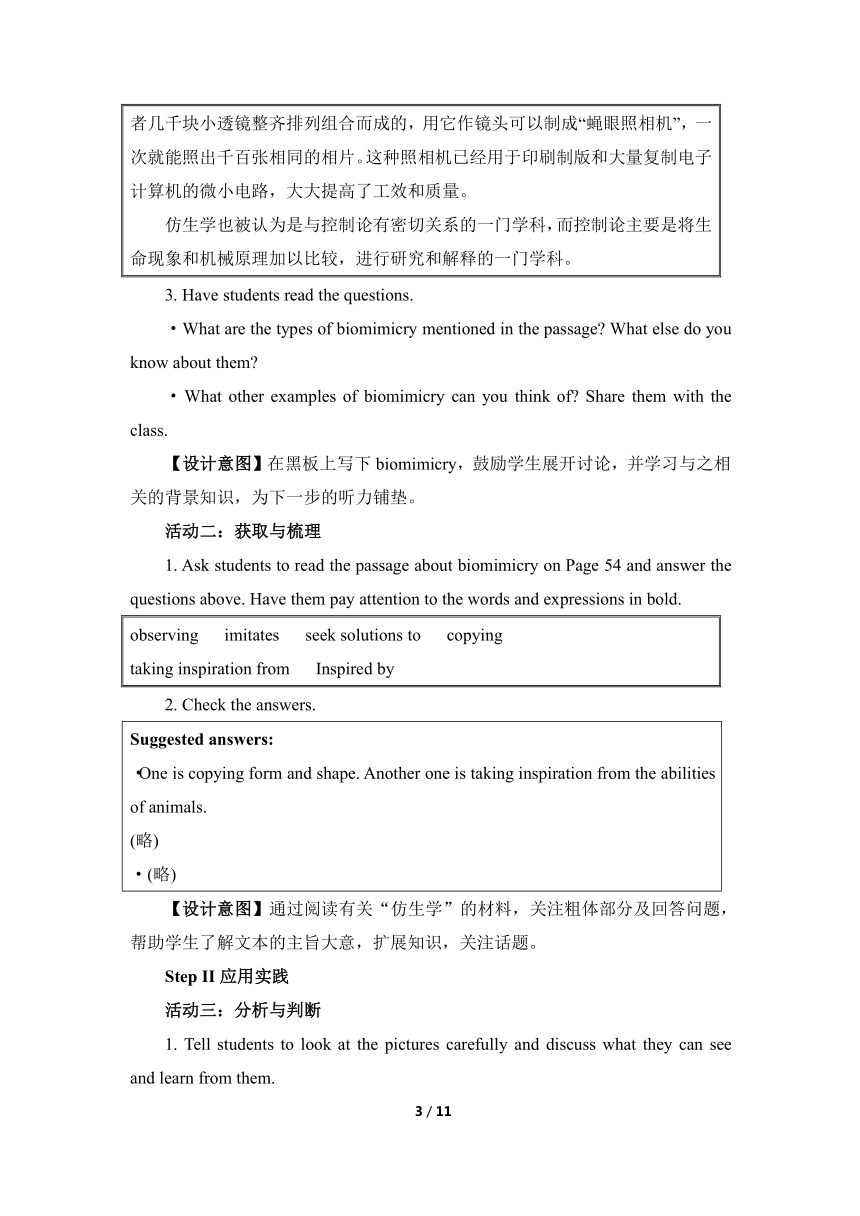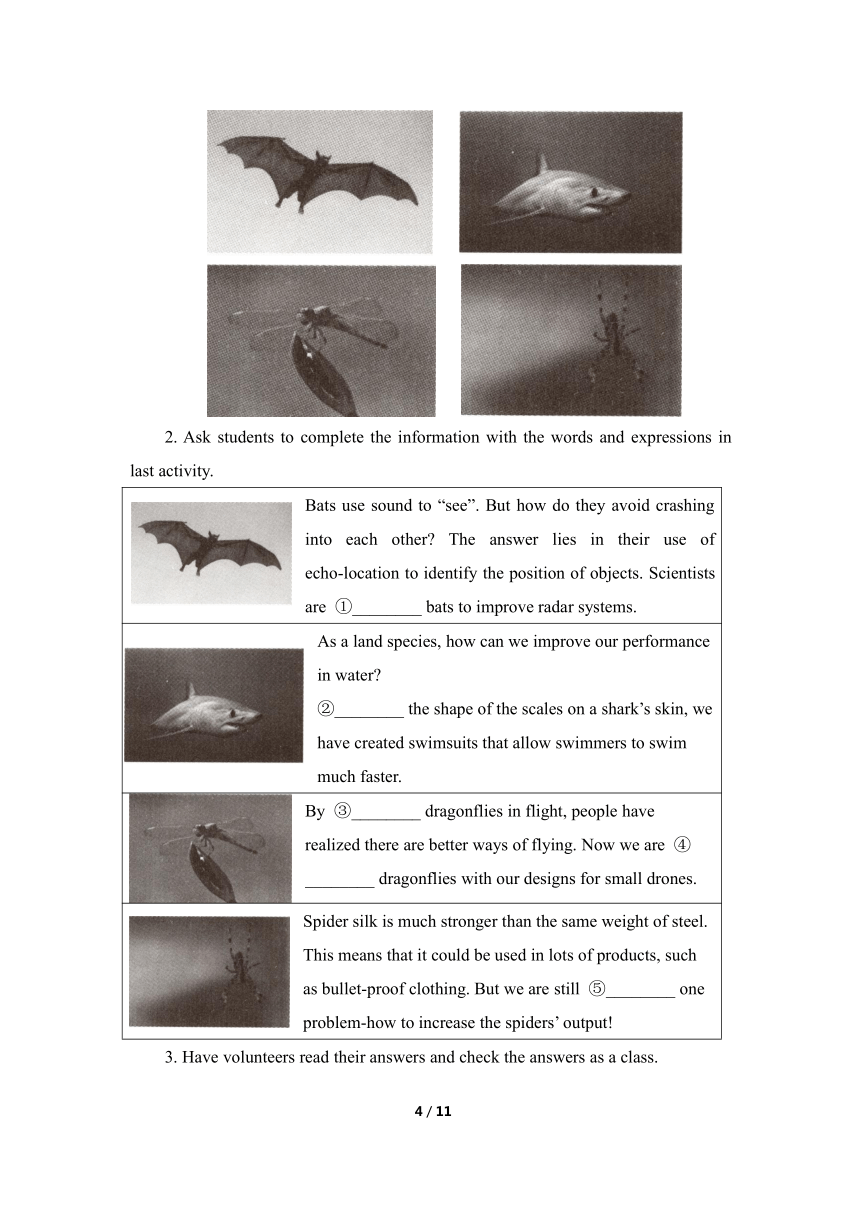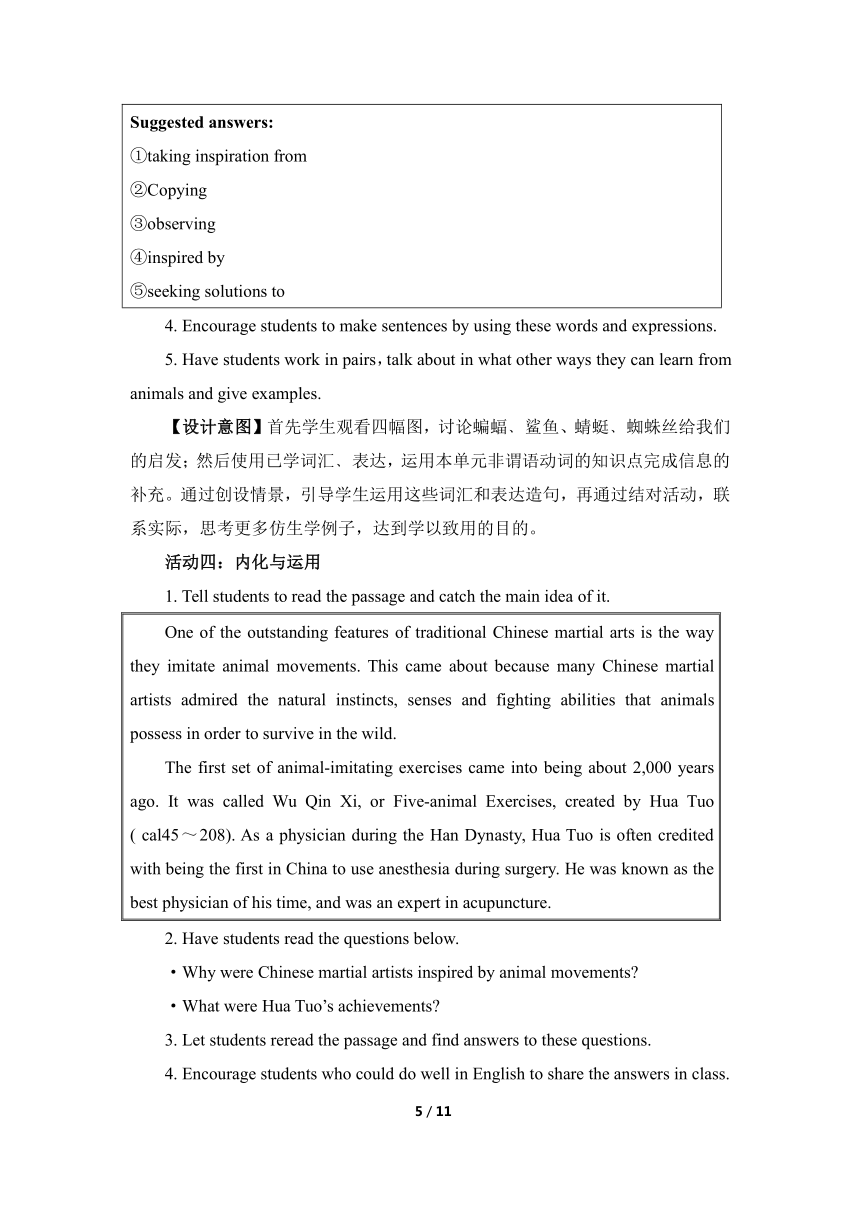外研版(2019)高中英语选择性必修第三册 Unit5 Learning from nature Using Language(2) 名师教学设计
文档属性
| 名称 | 外研版(2019)高中英语选择性必修第三册 Unit5 Learning from nature Using Language(2) 名师教学设计 |

|
|
| 格式 | docx | ||
| 文件大小 | 2.0MB | ||
| 资源类型 | 教案 | ||
| 版本资源 | 外研版(2019) | ||
| 科目 | 英语 | ||
| 更新时间 | 2023-03-06 21:20:24 | ||
图片预览





文档简介
Unit 5 Using Language(2) 名师教学设计
课时内容
Inspiration from animals
主题语境:人与自然
主题群:自然生态
子主题:人类向自然界学习
语篇类型:图片、说明文、音频
文本分析:
[what]本课时为综合语言运用。首先阅读有关仿生学及应用的材料,再学习五禽戏的背景知识,然后听有关材料,学习相关表达的含义及语用功能,并在具体语境中运用。
[Why]通过听力训练和阅读语篇,帮助学生深度聚焦语言的意义和功能,提高综合语言运用能力。
[How]本课包含一段听力材料和两个阅读语篇,话题为“从动物身上获得的灵感”,涉及仿生学和五禽戏,语言简练,结构紧凑。
课时目标
1. 了解仿生学的概念、应用实例﹑作用、意义及发展前沿和前景,能够恰当地讨论其益处。
2. 了解五禽戏的背景知识,学习相关词汇和表达,并能正确运用,合理进行造句和编造对话。
3. 培养模仿大自然的能力和创新能力。
4. 关注语法的语用功能,在真实语境中进行思考和交际运用。
重点难点
重点:
1. 了解仿生学和五禽戏的相关知识。
2. 学习相关词汇和表达,并能正确运用,合理进行造句和编造对话。
难点:
1. 谈论仿生学和五禽戏的益处并表示兴趣。
2. 关注非谓语动词的语用功能,并能在实际情境中运用。
教学准备
教师准备:
1. 仿生学和五禽戏的相关信息。
2. 更多仿生学的例子。
3.音频材料。
学生准备:
1. 预习本课词汇。
2. 贴近现实生活的仿生学的例子。
教学过程
Step I学习理解
活动一:感知与注意
1. Write “biomimicry” on the blackboard and have students discuss what they knew about it.
2. Encourage students to surf online for more information about biomimicry.
Related information: 仿生学是一门既古老又年轻的学科,是以自然为灵感,解决地球上人类面临的问题的一个分支。人们研究生物体的结构与功能的工作原理,并根据这些原理发明出新的设备、工具和科技,创造出适用于生产、学习和生活的先进技术。 仿生学一词是1960年由美国斯蒂尔根据拉丁文构成Bionics一词,后来演变成Biomimetics。1997年Janine Benyus首次提出Biomimicry一词。某些生物具有的功能迄今比任何人工制造的机械都优越得多,仿生学就是要在工程上实现并有效地应用生物功能的一门学科。例如关于信息接受(感觉功能)、信息传递(神经功能)、自动控制系统等,这种生物体的结构与功能在机械设计方面给了很大启发。 仿生学的例子有很多,如将海豚的体形或皮肤结构(游泳时能使身体表面不产生紊流)应用到潜艇设计原理上。又比如,苍蝇是细菌的传播者,一般归类为害虫,可是苍蝇的楫翅是天然导航仪。而且,它的眼睛是一种“复眼”,由3000 多只小眼组成,人们模仿它制成了“蝇眼透镜”。“蝇眼透镜”是用几百或者几千块小透镜整齐排列组合而成的,用它作镜头可以制成“蝇眼照相机”,一次就能照出千百张相同的相片。这种照相机已经用于印刷制版和大量复制电子计算机的微小电路,大大提高了工效和质量。 仿生学也被认为是与控制论有密切关系的一门学科,而控制论主要是将生命现象和机械原理加以比较,进行研究和解释的一门学科。
3. Have students read the questions.
·What are the types of biomimicry mentioned in the passage What else do you know about them
·What other examples of biomimicry can you think of Share them with the class.
【设计意图】在黑板上写下biomimicry,鼓励学生展开讨论,并学习与之相关的背景知识,为下一步的听力铺垫。
活动二:获取与梳理
1. Ask students to read the passage about biomimicry on Page 54 and answer the questions above. Have them pay attention to the words and expressions in bold.
observing imitates seek solutions to copying taking inspiration from Inspired by
2. Check the answers.
Suggested answers: ·One is copying form and shape. Another one is taking inspiration from the abilities of animals. (略) ·(略)
【设计意图】通过阅读有关“仿生学”的材料,关注粗体部分及回答问题,帮助学生了解文本的主旨大意,扩展知识,关注话题。
Step II应用实践
活动三:分析与判断
1. Tell students to look at the pictures carefully and discuss what they can see and learn from them.
2. Ask students to complete the information with the words and expressions in last activity.
Bats use sound to “see”. But how do they avoid crashing into each other The answer lies in their use of echo-location to identify the position of objects. Scientists are ①________ bats to improve radar systems.
As a land species, how can we improve our performance in water ②________ the shape of the scales on a shark’s skin, we have created swimsuits that allow swimmers to swim much faster.
By ③________ dragonflies in flight, people have realized there are better ways of flying. Now we are ④________ dragonflies with our designs for small drones.
Spider silk is much stronger than the same weight of steel. This means that it could be used in lots of products, such as bullet-proof clothing. But we are still ⑤________ one problem-how to increase the spiders’ output!
3. Have volunteers read their answers and check the answers as a class.
Suggested answers: ①taking inspiration from ②Copying ③observing ④inspired by ⑤seeking solutions to
4. Encourage students to make sentences by using these words and expressions.
5. Have students work in pairs,talk about in what other ways they can learn from animals and give examples.
【设计意图】首先学生观看四幅图,讨论蝙蝠﹑鲨鱼、蜻蜓﹑蜘蛛丝给我们的启发;然后使用已学词汇﹑表达,运用本单元非谓语动词的知识点完成信息的补充。通过创设情景,引导学生运用这些词汇和表达造句,再通过结对活动,联系实际,思考更多仿生学例子,达到学以致用的目的。
活动四:内化与运用
1. Tell students to read the passage and catch the main idea of it.
One of the outstanding features of traditional Chinese martial arts is the way they imitate animal movements. This came about because many Chinese martial artists admired the natural instincts, senses and fighting abilities that animals possess in order to survive in the wild. The first set of animal-imitating exercises came into being about 2,000 years ago. It was called Wu Qin Xi, or Five-animal Exercises, created by Hua Tuo ( cal45~208). As a physician during the Han Dynasty, Hua Tuo is often credited with being the first in China to use anesthesia during surgery. He was known as the best physician of his time, and was an expert in acupuncture.
2. Have students read the questions below.
·Why were Chinese martial artists inspired by animal movements
·What were Hua Tuo’s achievements
3. Let students reread the passage and find answers to these questions.
4. Encourage students who could do well in English to share the answers in class.
Suggested answers: ·Because many Chinese martial artists admired the natural instincts,senses and fighting abilities that animals possess in order to survive in the wild. ·Hua Tuo created Wu Qin Xi. He was the first physician to use anesthesia during surgery in China. He was known as the best physician of his time and he was an expert in acupuncture.
【设计意图】通过阅读语篇,了解五禽戏的背景知识,为听说活动作准备。
Step Ⅲ 迁移创新
活动五:推理与论证
1. Lead students to look at the picture and discuss.
2. Encourage students to search for and share related information about Wu Qin Xi.
Related information: 华佗在《庄子》“二禽戏”(“熊经鸟伸”)的基础上创编了“五禽戏”。其名称及功效据《后汉书·方术列传·华佗传》记载:“吾有一术,名五禽之戏:一曰虎,二曰鹿,三曰熊,四曰猿,五曰鸟。亦以除疾,兼利蹄足,以当导引。体有不快,起作一禽之戏,怡而汗出,因以着粉,身体轻便而欲食。普施行之,年九十余,耳目聪明,齿牙完坚。” 南北朝时陶弘景在其《养性延命录》中有比较详细的记载:“虎戏者,四肢距地,前三掷,却二掷,长引腰,侧脚仰天,即返距行,前、却各七过也。鹿戏者,四肢距地,引项反顾,左三右二,左右伸脚,伸缩亦三亦二也。熊戏者,正仰以两手抱膝下,举头,左僻地七,右亦七,蹲地,以手左右托地。猿戏者,攀物自悬,伸缩身体,上下一七,以脚拘物自悬,左右七,手钩却立,按头各七。鸟戏者,双立手,翘一足,伸两臂,扬眉鼓力,各二七,坐伸脚,手挽足距各七,缩伸二臂各七也。夫五禽戏法,任力为之,以汗出为度,有汗以粉涂身,消谷食,益气力,除百病,能存行之者,必得延年”。陶弘景在该书中,不但对五禽戏的具体操作步骤进行了描绘,而且提出了五禽戏的锻炼原则——“任力为之,以汗出为度”。
3. Have students listen to the conversation about Wu Qin Xi and tick the topics mentioned by the speakers.
□The creator of Wu Qin Xi
□Who can practise the exercises
□Why these animals were chosen
□Physical benefits
□Mental benefits
□How to teach the exercises
Suggested answers: The creator of Wu Qin Xi; Physical benefits; Mental benefits
4. Let students listen again and complete the introduction to Wu Qin Xi.
Wu Qin Xi was created by Hua Tuo almost 2,000 years ago. It means “Five-animal Exercises”, and each animal is ①________. By doing these exercises, people learn from these animals and help ②________. For example, the tiger exercise ③________ the liver. The bear exercise helps people with good digestion. The monkey exercise helps ④________; the ⑤________ is good for the kidney; and the crane exercise is ⑥________ Some people believe Wu Qin Xi helps them ⑦________ Some of the Wu Qin Xi masters lived to ⑧________, and still had good eyesight, hearing and strong teeth. Wu Qin Xi has ⑨________, too. It can help ⑩________.
Suggested answers: ①identified with a form of exercise ②the/their organs to work better ③does good to ④the heart to work well ⑤deer exercise ⑥good for the lung ⑦to live to an advanced age ⑧more than 90 years of age ⑨mental benefits ⑩to relax the mind and improve concentration
5. Ask students to complete the boxes with the expressions from the conversation.
·By..., you learn... ·That’s interesting! ·Really ·That’s very impressive. ·It helps people to... ·Sounds great! ·... is good for...
Talking about benefits Showing interest
Suggested answers: Talking about benefits ·By..., you learn.... ·It helps people to.... ·...is good for... Showing interest ·Really ·That’s interesting! ·That’s very impressive. ·Sounds great!
6. Encourage students to make sentences or dialogues by using these expressions.
【设计意图】通过观察图片,了解更多五禽戏知识;阅读六个话题,获取听力任务;听第一遍录音,找到材料中涉及的三个话题;听第二遍录音,获取细节信息,完成填空练习;学习相关表达,讨论其在真实语境中的使用情况,并尝试造句或编对话。
活动六:想象与创造
1. Ask students to work in pairs and think about other exercises inspired by animals. Have them discuss how they were created and their benefits, using the words and expressions in this section.
2. Encourage students to do further research on the Internet if necessary.
3. Tell students to comment on each other’s performances in using the words and expressions in this section.
【设计意图】引导学生结合“说”的技能,描述自己了解的从动物身上获得灵感而产生的运动形式,鼓励学生在具体语境中尽可能多地运用所学词汇和表达,多渠道获取学习资源,自主高效地开展学习,实现知识和能力的迁移,促进语言运用的自动化。
4. Talk more about what we have learnt from animals.
【设计意图】鼓励学生谈论更多仿生学的例子,了解仿生学的前沿,预测仿生学的前景,使学生明白仿生学会随着信息技术向网格和智能化方向发展,模仿自然有无限的潜力和机会,有利于提升人类原始创新的能力。
板书设计
Unit 5 Learning from nature Period III Using language (2) I. 学习理解 活动一:感知与注意 1. Discuss “biomimicry”. 2. Surf online for more information. 3. Read the questions. 活动二:获取与梳理 1. Read and answer. 2. Check the answers. Ⅱ. 应用实践 活动三:分析与判断 1. Look and discuss. 2. Complete the information. 3. Check the answers. 4. Make sentences. 5. Give other examples. 活动四:内化与运用 1. Read the passage. 2. Read the questions. 3. Reread and answer. 4. Share answers. Ⅲ. 迁移创新 活动五:推理与论证 1. Look and discuss. 2. Search for more information. 3. Listen. 4. Listen and complete. 5. Complete the boxes. 6. Make sentences or dialogues. 活动六:想象与创造 1. Think and discuss. 2. Do further research. 3. Comment. 4. Talk.
4 / 4
课时内容
Inspiration from animals
主题语境:人与自然
主题群:自然生态
子主题:人类向自然界学习
语篇类型:图片、说明文、音频
文本分析:
[what]本课时为综合语言运用。首先阅读有关仿生学及应用的材料,再学习五禽戏的背景知识,然后听有关材料,学习相关表达的含义及语用功能,并在具体语境中运用。
[Why]通过听力训练和阅读语篇,帮助学生深度聚焦语言的意义和功能,提高综合语言运用能力。
[How]本课包含一段听力材料和两个阅读语篇,话题为“从动物身上获得的灵感”,涉及仿生学和五禽戏,语言简练,结构紧凑。
课时目标
1. 了解仿生学的概念、应用实例﹑作用、意义及发展前沿和前景,能够恰当地讨论其益处。
2. 了解五禽戏的背景知识,学习相关词汇和表达,并能正确运用,合理进行造句和编造对话。
3. 培养模仿大自然的能力和创新能力。
4. 关注语法的语用功能,在真实语境中进行思考和交际运用。
重点难点
重点:
1. 了解仿生学和五禽戏的相关知识。
2. 学习相关词汇和表达,并能正确运用,合理进行造句和编造对话。
难点:
1. 谈论仿生学和五禽戏的益处并表示兴趣。
2. 关注非谓语动词的语用功能,并能在实际情境中运用。
教学准备
教师准备:
1. 仿生学和五禽戏的相关信息。
2. 更多仿生学的例子。
3.音频材料。
学生准备:
1. 预习本课词汇。
2. 贴近现实生活的仿生学的例子。
教学过程
Step I学习理解
活动一:感知与注意
1. Write “biomimicry” on the blackboard and have students discuss what they knew about it.
2. Encourage students to surf online for more information about biomimicry.
Related information: 仿生学是一门既古老又年轻的学科,是以自然为灵感,解决地球上人类面临的问题的一个分支。人们研究生物体的结构与功能的工作原理,并根据这些原理发明出新的设备、工具和科技,创造出适用于生产、学习和生活的先进技术。 仿生学一词是1960年由美国斯蒂尔根据拉丁文构成Bionics一词,后来演变成Biomimetics。1997年Janine Benyus首次提出Biomimicry一词。某些生物具有的功能迄今比任何人工制造的机械都优越得多,仿生学就是要在工程上实现并有效地应用生物功能的一门学科。例如关于信息接受(感觉功能)、信息传递(神经功能)、自动控制系统等,这种生物体的结构与功能在机械设计方面给了很大启发。 仿生学的例子有很多,如将海豚的体形或皮肤结构(游泳时能使身体表面不产生紊流)应用到潜艇设计原理上。又比如,苍蝇是细菌的传播者,一般归类为害虫,可是苍蝇的楫翅是天然导航仪。而且,它的眼睛是一种“复眼”,由3000 多只小眼组成,人们模仿它制成了“蝇眼透镜”。“蝇眼透镜”是用几百或者几千块小透镜整齐排列组合而成的,用它作镜头可以制成“蝇眼照相机”,一次就能照出千百张相同的相片。这种照相机已经用于印刷制版和大量复制电子计算机的微小电路,大大提高了工效和质量。 仿生学也被认为是与控制论有密切关系的一门学科,而控制论主要是将生命现象和机械原理加以比较,进行研究和解释的一门学科。
3. Have students read the questions.
·What are the types of biomimicry mentioned in the passage What else do you know about them
·What other examples of biomimicry can you think of Share them with the class.
【设计意图】在黑板上写下biomimicry,鼓励学生展开讨论,并学习与之相关的背景知识,为下一步的听力铺垫。
活动二:获取与梳理
1. Ask students to read the passage about biomimicry on Page 54 and answer the questions above. Have them pay attention to the words and expressions in bold.
observing imitates seek solutions to copying taking inspiration from Inspired by
2. Check the answers.
Suggested answers: ·One is copying form and shape. Another one is taking inspiration from the abilities of animals. (略) ·(略)
【设计意图】通过阅读有关“仿生学”的材料,关注粗体部分及回答问题,帮助学生了解文本的主旨大意,扩展知识,关注话题。
Step II应用实践
活动三:分析与判断
1. Tell students to look at the pictures carefully and discuss what they can see and learn from them.
2. Ask students to complete the information with the words and expressions in last activity.
Bats use sound to “see”. But how do they avoid crashing into each other The answer lies in their use of echo-location to identify the position of objects. Scientists are ①________ bats to improve radar systems.
As a land species, how can we improve our performance in water ②________ the shape of the scales on a shark’s skin, we have created swimsuits that allow swimmers to swim much faster.
By ③________ dragonflies in flight, people have realized there are better ways of flying. Now we are ④________ dragonflies with our designs for small drones.
Spider silk is much stronger than the same weight of steel. This means that it could be used in lots of products, such as bullet-proof clothing. But we are still ⑤________ one problem-how to increase the spiders’ output!
3. Have volunteers read their answers and check the answers as a class.
Suggested answers: ①taking inspiration from ②Copying ③observing ④inspired by ⑤seeking solutions to
4. Encourage students to make sentences by using these words and expressions.
5. Have students work in pairs,talk about in what other ways they can learn from animals and give examples.
【设计意图】首先学生观看四幅图,讨论蝙蝠﹑鲨鱼、蜻蜓﹑蜘蛛丝给我们的启发;然后使用已学词汇﹑表达,运用本单元非谓语动词的知识点完成信息的补充。通过创设情景,引导学生运用这些词汇和表达造句,再通过结对活动,联系实际,思考更多仿生学例子,达到学以致用的目的。
活动四:内化与运用
1. Tell students to read the passage and catch the main idea of it.
One of the outstanding features of traditional Chinese martial arts is the way they imitate animal movements. This came about because many Chinese martial artists admired the natural instincts, senses and fighting abilities that animals possess in order to survive in the wild. The first set of animal-imitating exercises came into being about 2,000 years ago. It was called Wu Qin Xi, or Five-animal Exercises, created by Hua Tuo ( cal45~208). As a physician during the Han Dynasty, Hua Tuo is often credited with being the first in China to use anesthesia during surgery. He was known as the best physician of his time, and was an expert in acupuncture.
2. Have students read the questions below.
·Why were Chinese martial artists inspired by animal movements
·What were Hua Tuo’s achievements
3. Let students reread the passage and find answers to these questions.
4. Encourage students who could do well in English to share the answers in class.
Suggested answers: ·Because many Chinese martial artists admired the natural instincts,senses and fighting abilities that animals possess in order to survive in the wild. ·Hua Tuo created Wu Qin Xi. He was the first physician to use anesthesia during surgery in China. He was known as the best physician of his time and he was an expert in acupuncture.
【设计意图】通过阅读语篇,了解五禽戏的背景知识,为听说活动作准备。
Step Ⅲ 迁移创新
活动五:推理与论证
1. Lead students to look at the picture and discuss.
2. Encourage students to search for and share related information about Wu Qin Xi.
Related information: 华佗在《庄子》“二禽戏”(“熊经鸟伸”)的基础上创编了“五禽戏”。其名称及功效据《后汉书·方术列传·华佗传》记载:“吾有一术,名五禽之戏:一曰虎,二曰鹿,三曰熊,四曰猿,五曰鸟。亦以除疾,兼利蹄足,以当导引。体有不快,起作一禽之戏,怡而汗出,因以着粉,身体轻便而欲食。普施行之,年九十余,耳目聪明,齿牙完坚。” 南北朝时陶弘景在其《养性延命录》中有比较详细的记载:“虎戏者,四肢距地,前三掷,却二掷,长引腰,侧脚仰天,即返距行,前、却各七过也。鹿戏者,四肢距地,引项反顾,左三右二,左右伸脚,伸缩亦三亦二也。熊戏者,正仰以两手抱膝下,举头,左僻地七,右亦七,蹲地,以手左右托地。猿戏者,攀物自悬,伸缩身体,上下一七,以脚拘物自悬,左右七,手钩却立,按头各七。鸟戏者,双立手,翘一足,伸两臂,扬眉鼓力,各二七,坐伸脚,手挽足距各七,缩伸二臂各七也。夫五禽戏法,任力为之,以汗出为度,有汗以粉涂身,消谷食,益气力,除百病,能存行之者,必得延年”。陶弘景在该书中,不但对五禽戏的具体操作步骤进行了描绘,而且提出了五禽戏的锻炼原则——“任力为之,以汗出为度”。
3. Have students listen to the conversation about Wu Qin Xi and tick the topics mentioned by the speakers.
□The creator of Wu Qin Xi
□Who can practise the exercises
□Why these animals were chosen
□Physical benefits
□Mental benefits
□How to teach the exercises
Suggested answers: The creator of Wu Qin Xi; Physical benefits; Mental benefits
4. Let students listen again and complete the introduction to Wu Qin Xi.
Wu Qin Xi was created by Hua Tuo almost 2,000 years ago. It means “Five-animal Exercises”, and each animal is ①________. By doing these exercises, people learn from these animals and help ②________. For example, the tiger exercise ③________ the liver. The bear exercise helps people with good digestion. The monkey exercise helps ④________; the ⑤________ is good for the kidney; and the crane exercise is ⑥________ Some people believe Wu Qin Xi helps them ⑦________ Some of the Wu Qin Xi masters lived to ⑧________, and still had good eyesight, hearing and strong teeth. Wu Qin Xi has ⑨________, too. It can help ⑩________.
Suggested answers: ①identified with a form of exercise ②the/their organs to work better ③does good to ④the heart to work well ⑤deer exercise ⑥good for the lung ⑦to live to an advanced age ⑧more than 90 years of age ⑨mental benefits ⑩to relax the mind and improve concentration
5. Ask students to complete the boxes with the expressions from the conversation.
·By..., you learn... ·That’s interesting! ·Really ·That’s very impressive. ·It helps people to... ·Sounds great! ·... is good for...
Talking about benefits Showing interest
Suggested answers: Talking about benefits ·By..., you learn.... ·It helps people to.... ·...is good for... Showing interest ·Really ·That’s interesting! ·That’s very impressive. ·Sounds great!
6. Encourage students to make sentences or dialogues by using these expressions.
【设计意图】通过观察图片,了解更多五禽戏知识;阅读六个话题,获取听力任务;听第一遍录音,找到材料中涉及的三个话题;听第二遍录音,获取细节信息,完成填空练习;学习相关表达,讨论其在真实语境中的使用情况,并尝试造句或编对话。
活动六:想象与创造
1. Ask students to work in pairs and think about other exercises inspired by animals. Have them discuss how they were created and their benefits, using the words and expressions in this section.
2. Encourage students to do further research on the Internet if necessary.
3. Tell students to comment on each other’s performances in using the words and expressions in this section.
【设计意图】引导学生结合“说”的技能,描述自己了解的从动物身上获得灵感而产生的运动形式,鼓励学生在具体语境中尽可能多地运用所学词汇和表达,多渠道获取学习资源,自主高效地开展学习,实现知识和能力的迁移,促进语言运用的自动化。
4. Talk more about what we have learnt from animals.
【设计意图】鼓励学生谈论更多仿生学的例子,了解仿生学的前沿,预测仿生学的前景,使学生明白仿生学会随着信息技术向网格和智能化方向发展,模仿自然有无限的潜力和机会,有利于提升人类原始创新的能力。
板书设计
Unit 5 Learning from nature Period III Using language (2) I. 学习理解 活动一:感知与注意 1. Discuss “biomimicry”. 2. Surf online for more information. 3. Read the questions. 活动二:获取与梳理 1. Read and answer. 2. Check the answers. Ⅱ. 应用实践 活动三:分析与判断 1. Look and discuss. 2. Complete the information. 3. Check the answers. 4. Make sentences. 5. Give other examples. 活动四:内化与运用 1. Read the passage. 2. Read the questions. 3. Reread and answer. 4. Share answers. Ⅲ. 迁移创新 活动五:推理与论证 1. Look and discuss. 2. Search for more information. 3. Listen. 4. Listen and complete. 5. Complete the boxes. 6. Make sentences or dialogues. 活动六:想象与创造 1. Think and discuss. 2. Do further research. 3. Comment. 4. Talk.
4 / 4
